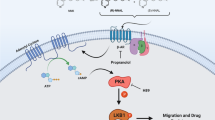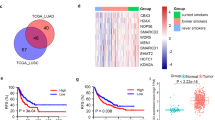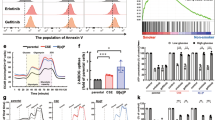Abstract
Serine/threonine kinase IKBKE is a newly identified oncogene; however, its regulation remains elusive. Here, we provide evidence that IKBKE is a downstream target of signal transducer and activator of transcription 3 (STAT3) and that tobacco components induce IKBKE expression through STAT3. Ectopic expression of constitutively active STAT3 increased IKBKE mRNA and protein levels, whereas inhibition of STAT3 reduced IKBKE expression. Furthermore, expression levels of IKBKE are significantly associated with STAT3 activation and tobacco use history in non-small cell lung cancer (NSCLC) patients examined. In addition, we show induction of IKBKE by two components of cigarette smoke, nicotine and nicotine-derived nitrosamine ketone (NNK). Upon exposure to nicotine or NNK, cells express high levels of IKBKE protein and mRNA, which are largely abrogated by inhibition of STAT3. Characterization of the IKBKE promoter revealed two STAT3-response elements. The IKBKE promoter directly bound to STAT3 and responded to nicotine and NNK stimulation. Notably, enforcing expression of IKBKE induces chemoresistance, whereas knockdown of IKBKE not only sensitizes NSCLC cells to chemotherapy but also abrogates STAT3- and nicotine-induced cell survival. These data indicate for the first time that IKBKE is a direct target of STAT3 and is induced by tobacco carcinogens through STAT3 pathway. In addition, our study also suggests that IKBKE is an important therapeutic target and could have a pivotal role in tobacco-associated lung carcinogenesis.
This is a preview of subscription content, access via your institution
Access options
Subscribe to this journal
Receive 50 print issues and online access
$259.00 per year
only $5.18 per issue
Buy this article
- Purchase on Springer Link
- Instant access to full article PDF
Prices may be subject to local taxes which are calculated during checkout






Similar content being viewed by others
Change history
05 March 2024
This article has been retracted. Please see the Retraction Notice for more detail: https://doi.org/10.1038/s41388-024-02993-7
References
Keen JC, Cianferoni A, Florio G, Guo J, Chen R, Roman J et al. Characterization of a novel PMA-inducible pathway of interleukin-13 gene expression in T cells. Immunology 2006; 117: 29–37.
Peters RT, Liao SM, Maniatis T . IKKepsilon is part of a novel PMA-inducible IkappaB kinase complex. Mol Cell 2000; 5: 513–522.
Fitzgerald KA, McWhirter SM, Faia KL, Rowe DC, Latz E, Golenbock DT et al. IKKepsilon and TBK1 are essential components of the IRF3 signaling pathway. Nat Immun 2003; 4: 491–496.
Harris J, Oliere S, Sharma S, Sun Q, Lin R, Hiscott J et al. Nuclear accumulation of cRel following C-terminal phosphorylation by TBK1/IKK epsilon. J Immun 2006; 177: 2527–2535.
Tenoever BR, Ng SL, Chua MA, McWhirter SM, Garcia-Sastre A, Maniatis T . Multiple functions of the IKK-related kinase IKKepsilon in interferon-mediated antiviral immunity. Science 2007; 315: 1274–1278.
Adli M, Baldwin AS . IKK-i/IKKepsilon controls constitutive, cancer cell-associated NF-kappaB activity via regulation of Ser-536 p65/RelA phosphorylation. J Biol Chem 2006; 281: 26976–26984.
Mattioli I, Geng H, Sebald A, Hodel M, Bucher C, Kracht M et al. Inducible phosphorylation of NF-kappa B p65 at serine 468 by T cell costimulation is mediated by IKK epsilon. J Biol Chem 2006; 281: 6175–6183.
Hutti JE, Shen RR, Abbott DW, Zhou AY, Sprott KM, Asara JM et al. Phosphorylation of the tumor suppressor CYLD by the breast cancer oncogene IKKepsilon promotes cell transformation. Mol Cell 2009; 34: 461–472.
Kovalenko A, Chable-Bessia C, Cantarella G, Israel A, Wallach D, Courtois G . The tumour suppressor CYLD negatively regulates NF-kappaB signalling by deubiquitination. Nature 2003; 424: 801–805.
Trompouki E, Hatzivassiliou E, Tsichritzis T, Farmer H, Ashworth A, Mosialos G . CYLD is a deubiquitinating enzyme that negatively regulates NF-kappaB activation by TNFR family members. Nature 2003; 424: 793–796.
Yoshida H, Jono H, Kai H, Li JD . The tumor suppressor cylindromatosis (CYLD) acts as a negative regulator for toll-like receptor 2 signaling via negative cross-talk with TRAF6 and TRAF7. J Biol Chem 2005; 280: 41111–41121.
Guo JP, Coppola D, Cheng JQ . IKBKE protein activates Akt independent of phosphatidylinositol 3-kinase/PDK1/mTORC2 and the pleckstrin homology domain to sustain malignant transformation. J Biol Chem 2011; 286: 37389–37398.
Xie X, Zhang D, Zhao B, Lu MK, You M, Condorelli G et al. IkappaB kinase epsilon and TANK-binding kinase 1 activate AKT by direct phosphorylation. Proc Natl Acad Sci USA 2011; 108: 6474–6479.
Boehm JS, Zhao JJ, Yao J, Kim SY, Firestein R, Dunn IF et al. Integrative genomic approaches identify IKBKE as a breast cancer oncogene. Cell 2007; 129: 1065–1079.
Eddy SF, Guo S, Demicco EG, Romieu-Mourez R, Landesman-Bollag E, Seldin DC et al. Inducible IkappaB kinase/IkappaB kinase epsilon expression is induced by CK2 and promotes aberrant nuclear factor-kappaB activation in breast cancer cells. Cancer Res 2005; 65: 11375–11383.
Guo JP, Shu SK, He L, Lee YC, Kruk PA, Grenman S et al. Deregulation of IKBKE is associated with tumor progression, poor prognosis, and cisplatin resistance in ovarian cancer. Am J Pathol 2009; 175: 324–333.
Guo JP, Shu SK, Esposito NN, Coppola D, Koomen JM, Cheng JQ . IKKepsilon phosphorylation of estrogen receptor alpha Ser-167 and contribution to tamoxifen resistance in breast cancer. J Biol Chem 2010; 285: 3676–3684.
Yu CL, Meyer DJ, Campbell GS, Larner AC, Carter-Su C, Schwartz J et al. Enhanced DNA-binding activity of a Stat3-related protein in cells transformed by the Src oncoprotein. Science 1995; 269: 81–83.
Yu H, Jove R . The STATs of cancer—new molecular targets come of age. Nat Rev Cancer 2004; 4: 97–105.
Chen RJ, Ho YS, Guo HR, Wang YJ . Rapid activation of Stat3 and ERK1/2 by nicotine modulates cell proliferation in human bladder cancer cells. J Soc Toxi 2008; 104: 283–293.
Vignais ML, Sadowski HB, Watling D, Rogers NC, Gilman M . Platelet-derived growth factor induces phosphorylation of multiple JAK family kinases and STAT proteins. Mol Cell Biol 1996; 16: 1759–1769.
Wen X, Lin HH, Shih HM, Kung HJ, Ann DK . Kinase activation of the non-receptor tyrosine kinase Etk/BMX alone is sufficient to transactivate STAT-mediated gene expression in salivary and lung epithelial cells. J Biol Chem 1999; 274: 38204–38210.
Barre B, Vigneron A, Coqueret O . The STAT3 transcription factor is a target for the Myc and riboblastoma proteins on the Cdc25A promoter. J Biol Chem 2005; 280: 15673–15681.
Epling-Burnette PK, Liu JH, Catlett-Falcone R, Turkson J, Oshiro M, Kothapalli R et al. Inhibition of STAT3 signaling leads to apoptosis of leukemic large granular lymphocytes and decreased Mcl-1 expression. J Clin Invest 2001; 107: 351–362.
Nakajima K, Yamanaka Y, Nakae K, Kojima H, Ichiba M, Kiuchi N et al. A central role for Stat3 in IL-6-induced regulation of growth and differentiation in M1 leukemia cells. EMBO J 1996; 15: 3651–3658.
Sinibaldi D, Wharton W, Turkson J, Bowman T, Pledger WJ, Jove R . Induction of p21WAF1/CIP1 and cyclin D1 expression by the Src oncoprotein in mouse fibroblasts: role of activated STAT3 signaling. Oncogene 2000; 19: 5419–5427.
Liu Y, Li C, Lin J . STAT3 as a therapeutic target for glioblastoma. Anticancer Agents Med Chem 2010; 10: 512–519.
Cheng A, Guo J, Henderson-Jackson E, Kim D, Malafa M, Coppola D . IκB Kinase ɛ expression in pancreatic ductal adenocarcinoma. Am J Clin Pathol 2011; 136: 60–66.
Chang KT, Tsai CM, Chiou YC, Chiu CH, Jeng KS, Huang CY . IL-6 induces neuroendocrine dedifferentiation and cell proliferation in non-small cell lung cancer cells. Am J Physiol 2005; 289: L446–L453.
Song L, Turkson J, Karras JG, Jove R, Haura EB . Activation of Stat3 by receptor tyrosine kinases and cytokines regulates survival in human non-small cell carcinoma cells. Oncogene 2003; 22: 4150–4165.
Stahl N, Farruggella TJ, Boulton TG, Zhong Z, Darnell Jr JE, Yancopoulos GD . Choice of STATs and other substrates specified by modular tyrosine-based motifs in cytokine receptors. Science 1995; 267: 1349–1353.
Dasgupta P, Chellappan SP . Nicotine-mediated cell proliferation and angiogenesis: new twists to an old story. Cell Cycle 2006; 5: 2324–2328.
Schuller HM, Plummer III HK, Jull BA . Receptor-mediated effects of nicotine and its nitrosated derivative NNK on pulmonary neuroendocrine cells. Anat Rec A Discov Mol Cell Evol Biol 2003; 270: 51–58.
Arredondo J, Chernyavsky AI, Jolkovsky DL, Pinkerton KE, Grando SA . Receptor-mediated tobacco toxicity: cooperation of the Ras/Raf-1/MEK1/ERK and JAK-2/STAT-3 pathways downstream of alpha7 nicotinic receptor in oral keratinocytes. FASEB J 2006; 20: 2093–2101.
Chen RJ, Ho YS, Guo HR, Wang YJ . Long-term nicotine exposure-induced chemoresistance is mediated by activation of Stat3 and downregulation of ERK1/2 via nAChR and beta-adrenoceptors in human bladder cancer cells. J Soc Toxi 2010; 115: 118–130.
Jull BA, Plummer III HK, Schuller HM . Nicotinic receptor-mediated activation by the tobacco-specific nitrosamine NNK of a Raf-1/MAP kinase pathway, resulting in phosphorylation of c-myc in human small cell lung carcinoma cells and pulmonary neuroendocrine cells. J Cancer Clin Oncol 2001; 127: 707–717.
West KA, Linnoila IR, Belinsky SA, Harris CC, Dennis PA . Tobacco carcinogen-induced cellular transformation increases activation of the phosphatidylinositol 3′-kinase/Akt pathway in vitro and in vivo. Cancer Res 2004; 64: 446–451.
Hosur V, Loring RH . alpha4beta2 nicotinic receptors partially mediate anti-inflammatory effects through Janus kinase 2-signal transducer and activator of transcription 3 but not calcium or cAMP signaling. Mol Pharma 2011; 79: 167–174.
Mai H, May WS, Gao F, Jin Z, Deng X . A functional role for nicotine in Bcl2 phosphorylation and suppression of apoptosis. J Biol Chem 2003; 278: 1886–1891.
Fan J, Wang XJ, Jiang GN, Wang L, Zu XW, Zhou X et al. Survival and outcomes of surgical treatment of the elderly NSCLC in China: a retrospective matched cohort study. Eur J Surg Oncol 2007; 33: 639–643.
Yu H, Pardoll D, Jove R . STATs in cancer inflammation and immunity: a leading role for STAT3. Nat Rev Cancer 2009; 9: 798–809.
Tsurutani J, Castillo SS, Brognard J, Granville CA, Zhang C, Gills JJ et al. Tobacco components stimulate Akt-dependent proliferation and NFkappaB-dependent survival in lung cancer cells. Carcinogenesis 2005; 26: 1182–1195.
West KA, Brognard J, Clark AS, Linnoila IR, Yang X, Swain SM et al. Rapid Akt activation by nicotine and a tobacco carcinogen modulates the phenotype of normal human airway epithelial cells. J Clin Invest 2003; 111: 81–90.
Liu X . STAT3 activation inhibits human bronchial epithelial cell apoptosis in response to cigarette smoke exposure. BBRC 2007; 353: 121–126.
Shimada T, Kawai T, Takeda K, Matsumoto M, Inoue J, Tatsumi Y et al. IKK-i, a novel lipopolysaccharide-inducible kinase that is related to IkappaB kinases. Int Immunol 1999; 11: 1357–1362.
Wang N, Ahmed S, Haqqi TM . Genomic structure and functional characterization of the promoter region of human IkappaB kinase-related kinase IKKi/IKKvarepsilon gene. Gene 2005; 353: 118–133.
Nadiminty N, Lou W, Lee SO, Lin X, Trump DL, Gao AC . Stat3 activation of NF-{kappa}B p100 processing involves CBP/p300-mediated acetylation. Proc Natl Acad Sci USA 2006; 103: 7264–7269.
Memmott RM, Dennis PA . The role of the Akt/mTOR pathway in tobacco carcinogen-induced lung tumorigenesis. Clin Cancer Res 2010; 16: 4–10.
Haura EB, Zheng Z, Song L, Cantor A, Bepler G . Activated epidermal growth factor receptor-Stat-3 signaling promotes tumor survival in vivo in non-small cell lung cancer. Clin Cancer Res 2005; 11: 8288–8294.
Sierra J, Villagra A, Paredes R, Cruzat F, Gutierrez S, Javed A et al. Regulation of the bone-specific osteocalcin gene by p300 requires Runx2/Cbfa1 and the vitamin D3 receptor but not p300 intrinsic histone acetyltransferase activity. Mol Cell Biol 2003; 23: 3339–3351.
Acknowledgements
We are grateful to Tissue Procurement, DNA Sequence and Image Core Facilities at H Lee Moffitt Cancer Center for providing cancer specimens, sequencing and cell apoptosis analysis as well as Fumi Kinose for helping provide lung cancer cell lines from the Moffitt lung cancer cell line core. This work was supported by NCI Grants CA137041 (JQC) and P50 CA119997 (EBH) and James and Esther King Biomedical Research Program 1KG02 (JQC), 1KD04 (JG) and 1KN08 (DK).
Author information
Authors and Affiliations
Corresponding author
Ethics declarations
Competing interests
The authors declare no conflict of interest.
Additional information
Supplementary Information accompanies the paper on the Oncogene website
Supplementary information
About this article
Cite this article
Guo, J., Kim, D., Gao, J. et al. RETRACTED ARTICLE: IKBKE is induced by STAT3 and tobacco carcinogen and determines chemosensitivity in non-small cell lung cancer. Oncogene 32, 151–159 (2013). https://doi.org/10.1038/onc.2012.39
Received:
Revised:
Accepted:
Published:
Issue Date:
DOI: https://doi.org/10.1038/onc.2012.39
Keywords
This article is cited by
-
Carcinogenicity of nicotine and signal pathways in cancer progression: a review
Environmental Chemistry Letters (2024)
-
Inhibitor of nuclear factor kappa B kinase subunit epsilon regulates murine acetaminophen toxicity via RIPK1/JNK
Cell Biology and Toxicology (2023)
-
Silencing IKBKE inhibits the migration and invasion of glioblastoma by promoting Snail1 degradation
Clinical and Translational Oncology (2022)
-
Local anesthetics impair the growth and self-renewal of glioblastoma stem cells by inhibiting ZDHHC15-mediated GP130 palmitoylation
Stem Cell Research & Therapy (2021)
-
CYT387, a potent IKBKE inhibitor, suppresses human glioblastoma progression by activating the Hippo pathway
Journal of Translational Medicine (2021)



